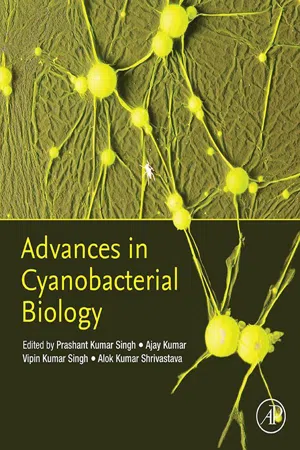
Advances in Cyanobacterial Biology
- 420 pages
- English
- ePUB (mobile friendly)
- Available on iOS & Android
Advances in Cyanobacterial Biology
About This Book
Advances in Cyanobacterial Biology presents the novel, practical, and theoretical aspects of cyanobacteria, providing a better understanding of basic and advanced biotechnological application in the field of sustainable agriculture. Chapters have been designed to deal with the different aspects of cyanobacteria including their role in the evolution of life, cyanobacterial diversity and classification, isolation, and characterization of cyanobacteria through biochemical and molecular approaches, phylogeny and biogeography of cyanobacteria, symbiosis, Cyanobacterial photosynthesis, morphological and physiological adaptation to abiotic stresses, stress-tolerant cyanobacterium, biological nitrogen fixation. Other topics include circadian rhythms, genetics and molecular biology of abiotic stress responses, application of cyanobacteria and cyanobacterial mats in wastewater treatments, use as a source of novel stress-responsive genes for development of stress tolerance and as a source of biofuels, industrial application, as biofertilizer, cyanobacterial blooms, use in Nano-technology and nanomedicines as well as potential applications.
This book will be important for academics and researchers working in cyanobacteria, cyanobacterial environmental biology, cyanobacterial agriculture and cyanobacterial molecular biologists.
- Summarizes the various aspects of cyanobacterial research, from primary nitrogen fixation, to advanced nano-technology applications
- Addresses both practical and theoretical aspects of the cyanobacterial application
- Includes coverage of biochemical and molecular approaches for the identification, use and management of cyanobacteria
Frequently asked questions
Information
Cyanobacterial imprints in diversity and phylogeny
Abstract
Keywords
1.1 Introduction

1.2 Biodiversity of cyanobacteria
1.3 Morphological diversity–based classification
Table of contents
- Cover image
- Title page
- Table of Contents
- Copyright
- List of contributors
- Chapter 1. Cyanobacterial imprints in diversity and phylogeny
- Chapter 2. Cyanobacterial diversity: molecular insights under multifarious environmental conditions
- Chapter 3. Cyanobacteria in tropical and subtropical marine environments: bloom formation and ecological role
- Chapter 4. Database resources for cyanobacterial research
- Chapter 5. Cyanobacterial pigments and their fluorescence characteristics: applications in research and industry
- Chapter 6. Cyanobacterial membrane biology under environmental stresses with particular reference to photosynthesis and photomorphogenesis
- Chapter 7. Iron homeostasis of cyanobacteria: advancements in siderophores and metal transporters
- Chapter 8. Molecular chaperones in protein folding and stress management in cyanobacteria
- Chapter 9. Cyanobacterial genome editing toolboxes: recent advancement and future projections for basic and synthetic biology researches
- Chapter 10. Impact of pesticides applications on the growth and function of cyanobacteria
- Chapter 11. Cyanoomics: an advancement in the fields cyanobacterial omics biology with special reference to proteomics and transcriptomics
- Chapter 12. Algae and cyanobacteria as a source of novel bioactive compounds for biomedical applications
- Chapter 13. Cyanobacterial stress-responsive small RNAs (sRNAs): players of stress and developmental responses
- Chapter 14. Physiological aspects of cyanobacterial nitrogen fixation and its applications in modern sciences
- Chapter 15. Ultraviolet-screening compound mycosporine-like amino acids in cyanobacteria: biosynthesis, functions, and applications
- Chapter 16. Heterocyst and akinete differentiation in cyanobacteria: a view toward cyanobacterial symbiosis
- Chapter 17. Cyanobacterial peroxiredoxins and their role in cyanobacterial stress biology
- Chapter 18. Cyanobacteria as a biofuel source: advances and applications
- Chapter 19. Cyanobacteria: as a promising candidate for heavy-metals removal
- Chapter 20. Dynamics of harmful cyanobacterial blooms and their toxins: environmental and human health perspectives and management strategies
- Chapter 21. Cyanobacteria as a source of nanoparticle: application and future projections
- Chapter 22. Role of algae and cyanobacteria in bioremediation: prospects in polyethylene biodegradation
- Chapter 23. Cyanobacteria: potential source of biofertilizer and synthesizer of metallic nanoparticles
- Chapter 24. Cyanobacteria: a potential source of anticancer drugs
- Chapter 25. Cyanobacteria as a source of biofertilizers for sustainable agriculture
- Index